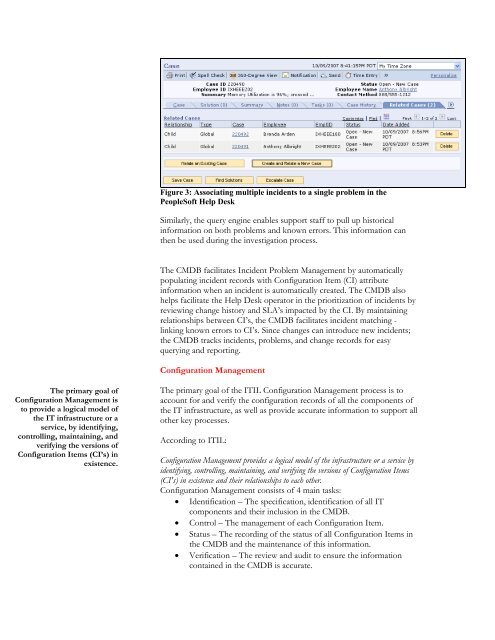ITIL Best Practices with Oracle Enterprise Manager 10g and Oracle ...
ITIL Best Practices with Oracle Enterprise Manager 10g and Oracle ...
ITIL Best Practices with Oracle Enterprise Manager 10g and Oracle ...
Create successful ePaper yourself
Turn your PDF publications into a flip-book with our unique Google optimized e-Paper software.
Figure 3: Associating multiple incidents to a single problem in the<br />
PeopleSoft Help Desk<br />
Similarly, the query engine enables support staff to pull up historical<br />
information on both problems <strong>and</strong> known errors. This information can<br />
then be used during the investigation process.<br />
The CMDB facilitates Incident Problem Management by automatically<br />
populating incident records <strong>with</strong> Configuration Item (CI) attribute<br />
information when an incident is automatically created. The CMDB also<br />
helps facilitate the Help Desk operator in the prioritization of incidents by<br />
reviewing change history <strong>and</strong> SLA’s impacted by the CI. By maintaining<br />
relationships between CI’s, the CMDB facilitates incident matching -<br />
linking known errors to CI’s. Since changes can introduce new incidents;<br />
the CMDB tracks incidents, problems, <strong>and</strong> change records for easy<br />
querying <strong>and</strong> reporting.<br />
Configuration Management<br />
The primary goal of<br />
Configuration Management is<br />
to provide a logical model of<br />
the IT infrastructure or a<br />
service, by identifying,<br />
controlling, maintaining, <strong>and</strong><br />
verifying the versions of<br />
Configuration Items (CI’s) in<br />
existence.<br />
The primary goal of the <strong>ITIL</strong> Configuration Management process is to<br />
account for <strong>and</strong> verify the configuration records of all the components of<br />
the IT infrastructure, as well as provide accurate information to support all<br />
other key processes.<br />
According to <strong>ITIL</strong>:<br />
Configuration Management provides a logical model of the infrastructure or a service by<br />
identifying, controlling, maintaining, <strong>and</strong> verifying the versions of Configuration Items<br />
(CI's) in existence <strong>and</strong> their relationships to each other.<br />
Configuration Management consists of 4 main tasks:<br />
• Identification – The specification, identification of all IT<br />
components <strong>and</strong> their inclusion in the CMDB.<br />
• Control – The management of each Configuration Item.<br />
• Status – The recording of the status of all Configuration Items in<br />
the CMDB <strong>and</strong> the maintenance of this information.<br />
• Verification – The review <strong>and</strong> audit to ensure the information<br />
contained in the CMDB is accurate.

















